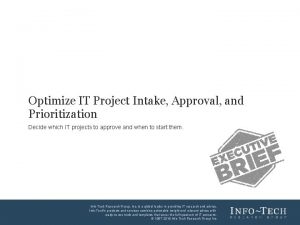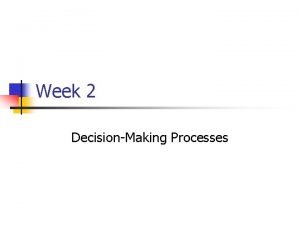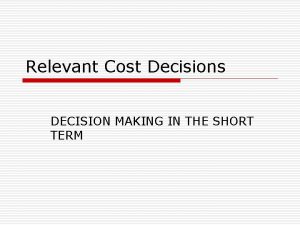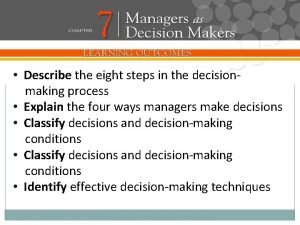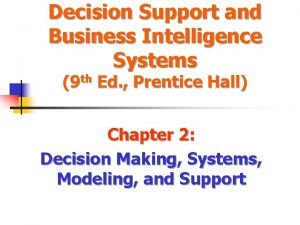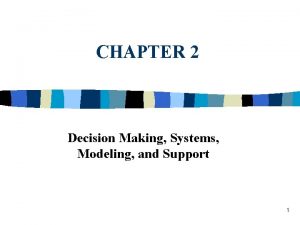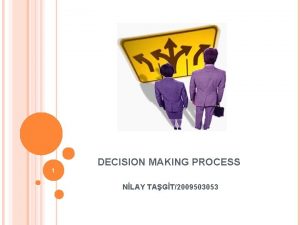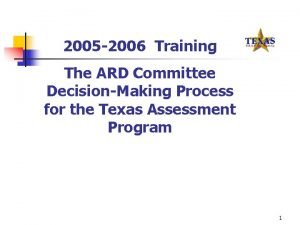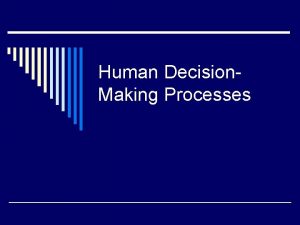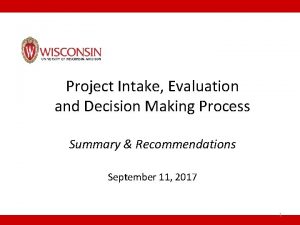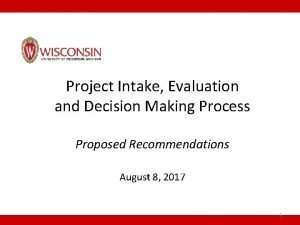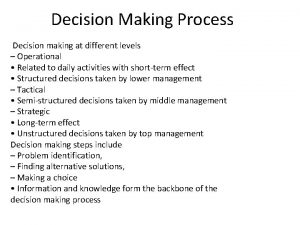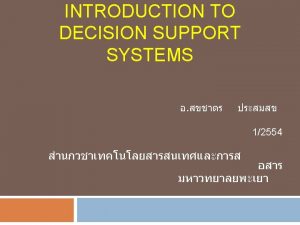Project Intake Evaluation and Decision Making Process Summary























- Slides: 23

Project Intake, Evaluation and Decision Making Process Summary & Recommendations September 15, 2017 1

Agenda ØScope of Work ØObjectives and Principles ØAssumptions ØOverall Approach ØProposed Process ØImplementation, Communication Plans 2

Scope of Work Ø Develop “IT Project Proposal” Definition Ø Create Project Proposal Intake Template Ø Develop Scoring/Classification Methodology, Routing Strategy Ø Route Proposals through IT Governance Ø Identify Issues, Types of Proposals that may Need Further Scrutiny by the IT Governance 3

Objectives and Principles Ø Rationalization Ø Prioritization Ø Minimize duplications and redundancies Ø Assess impact on IT infrastructure/resources capacities Ø Encourage innovation Ø Governance driven, collaborative, transparent, expert-based Ø Agility and flexibility Ø Pace/Speed 4

Benefits to “End Users” Examples: Ø Using existing software licenses Ø Collaboration, consolidation Ø Better chance getting needed resources Ø Assessing impact on campus infrastructure: Will benefit all Ø Having a central project repository 5

Assumptions Ø Mandatory Ø Vast majority of projects are expected to have their own funding: • This is NOT a “request for funding” process • Request for campus funding: A prioritized list will be taken to campus 3 times a year: September, January, May Ø Service Catalog and Project Repository will be used 6

Definition of “IT Project Proposal” ØA “Project Proposal” is a… “a request by a campus unit to create or significantly modify an IT service – including expanding the scope, functionality and/or capabilities of existing services - that is owned by the campus unit (department, college, school, administrative unit) and is designed to support the mission and the operational and managerial business needs of the unit with well-defined business outcomes. The service employs information technologies and resources, people, and processes to collect, manipulate, store and disseminate information to achieve its objectives. ” 7

Types of Services Ø Customer Facing • Projects that aim to develop or re-design services that deliver value to customers by facilitating outcomes customers want to achieve Ø Infrastructure Services • Projects that aim to develop or re-design services that deliver core infrastructure functionalities that enable customer-facing services Ø Innovative Projects • Proposals that aim to create new, innovative IT services 8

Who Can Submit a Project; Project Sponsor; Notifications to Divisional Officials Ø Divisional CIOs or directors occupying the highest office in the division/department/center (ex. : Dean, Associate Dean, CFO, Center Director): • have the authority to submit proposals. They can delegate that authority. Ø They should receive a copy of the proposal. Ø If a proposal seeks campus funding: The divisional CIO will notify divisional officers so they can weigh in on the proposal. Ø A project proposal should have a sponsor. The sponsor must approve the submission. 9

Intake Form ØIntake Form includes: • Project name and description; Proposer and sponsor information • Reasons for – purpose of - the Project • Proposed solution or general approach • Alignment with the campus strategic framework • Similar existing campus IT services or IT projects 10

Intake Form (continued) ØIntake Form includes: • Potential to become campus-wide service • Privacy, security concerns • Estimated cost and effort to complete and implement the project; to operate the solution • Scope of impact, including: o Users/Customers; Total num. of people that will be impacted • Impact on IT resources/infrastructure capacities 11

Scoring Process ØScoring/Classification Process • 10 questions will be scored • Each question will be scored on a scale of 1, 3, 5. Some of the questions are weighted • Aggregate weighted score determines Project Classification Aggregate Score 34 - 99 Project Classification Low Impact 100 - 139 Medium Impact 140 - 170 High Impact 12

Approval Process ØReview and Approval • Low Impact Proposals o Approved “automatically” • Medium and High Impact Proposals o Route to relevant TAGs for review, recommendations to IT Steering Committee (ITSC) o Review may require additional information o Route to ITSC for decision-making 13

Review in the CIO Office; “Red flags” Ø Additional information will be collected for Medium and High Impact proposals. Ø The initial review in the CIO Office will focus on proposals that need further scrutiny (proposals that raise “red flags”): • Seek campus funding • Duplicate existing services and/or projects • Have significant impact on the campus IT resources/infrastructure capabilities • Have the potential to become shared, campus-wide services; could benefit multiple campus units. • Have Federal, State or campus policy compliance implications 14

Review by Advisory Groups: Ø Review proposals; do additional analysis as they see fit. May interact with proposers and consult with subject matter experts (SMEs). Ø Review will primarily focus on the issues that need scrutiny by IT governance (“red flags”). Ø Make recommendations to the ITSC as necessary. 15

Decision-Making Ø The ITSC will make decisions about project proposals, based on recommendations by the Advisory Groups Ø Will focus on major issues and considerations (“red flags” issues) Ø Prioritize high impact projects, assemble a prioritized list of requests for campus funding, and take other necessary action(s). IT leadership will go to campus three times a year with a prioritized list of funding requests 16

Implementation Plan Ø The Intake Process will “go live” on Oct. 1, 2017 Ø Review Team in the CIO Office: • Executives/directors in the CIO Office. • Chairs of the Advisory Groups: DTAG, TLTAG, RTAG, IAG. • Professional staff: Business Analyst(s); Enterprise Architect(s). • Subject Matter Experts (as needed) • Administrative staff. 17

Implementation Plan (continued) Ø Reviewing issues that require further scrutiny (“red flags”): • Proposals that seem to duplicate an existing service or project: o The proposer/sponsor will be required to meet with the IT and/or business sponsors of existing similar services/projects in order to explore opportunities for collaboration and consolidation. • Proposals with significant impact on campus IT infrastructure and resources: o Review Team will periodically aggregate the impact of proposals on the campus IT infrastructure and resources. o Will engage “owners/managers” of IT infrastructure and resources to assess total effect on the campus infrastructure capacities and capabilities. 18

Implementation Plan (continued) Ø Review by Advisory Groups: • Cross-TAGs Standing Review Group, composed of: TAG members. Non-TAG members Subject-Matter Experts (SMEs) (as needed). • May also engage proposers/project-sponsors. • TAGs authorize the TAGs Review Group to act on behalf of the TAGs. • Analysis will primarily focus on “red flag” issues. The Group will present its analysis and recommendations to the Advisory Groups. • Review will be done monthly. 19

Advisory Groups Recommendations to the ITSC: Template Project Descrip- Name tion Red Flags campus duplicate impact poten. compli- funding service on to be shared ance infra- service issues structure 20 summary reco- Prio- analysis mend- rities ations

Communication Plan Ø Interim CIO: To Campus Leadership, Deans Ø CIO Office: • Broader message to all TAG members, Associate Deans/Directors, etc. • Orientation sessions to explain the Intake Form and submission process • “Project Intake Procedures and Guidelines” document 21

Discussion Questions: 1. Are we missing any relevant questions in the Intake Process? 2. Are we missing important impact filtering questions? 3. Do you recommend other issues, considerations, and types of proposals that will help Advisory Groups in making recommendations to the ITSC and that may need further scrutiny by the ITSC? 22

Project Intake, Evaluation and Decision Making Process – Questions? Thank you for your time and attention! 23
 No decision snap decision responsible decision
No decision snap decision responsible decision Slidetodoc.com
Slidetodoc.com Project intake and prioritization
Project intake and prioritization Demand intake process
Demand intake process Project intake process presentation
Project intake process presentation War making and state making as organized crime summary
War making and state making as organized crime summary Systematic decision making process
Systematic decision making process 5 step decision making process
5 step decision making process Consumer decision making process
Consumer decision making process Steps in decision making
Steps in decision making 8 steps of rational decision making
8 steps of rational decision making Systematic decision making process
Systematic decision making process Divestment in consumer decision process
Divestment in consumer decision process Decision making process consumer behavior
Decision making process consumer behavior Ongoing search consumer behavior
Ongoing search consumer behavior Systematic decision making process
Systematic decision making process Systematic decision making process
Systematic decision making process Unusual situations that have not been often addressed.
Unusual situations that have not been often addressed. 6 step decision making process
6 step decision making process Financial decision making process
Financial decision making process Ard committee decision making process
Ard committee decision making process Decision making process diagram by frank harrison
Decision making process diagram by frank harrison Mike xhaxho net worth
Mike xhaxho net worth Human decision making process
Human decision making process


